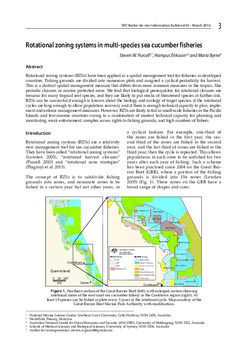Rotational zoning systems in multi-species sea cucumber fisheries

Citation
Purcell, S.W.; Eriksson, H.; Byrne, M. (2016). Rotational zoning systems in multi-species sea cucumber fisheries. SPC Beche-de-mer Information Bulletin, 36
Rotational zoning systems (RZSs) have been applied as a spatial management tool for fisheries in developed countries. Fishing grounds are divided into numerous plots and assigned a cyclical periodicity for harvest. This is a distinct spatial management measure that differs from more common measures in the tropics, like periodic closures or marine protected areas. We find that biological prerequisites for rotational closures are tenuous for many tropical reef species, and they are likely to put stocks of threatened species at further risk. RZSs can be successful if enough is known about the biology and ecology of target species, if the rotational cycles are long enough to allow population recovery, and if there is enough technical capacity to plan, implement and enforce management measures. However, RZSs are likely to fail in small-scale fisheries in the Pacific Islands and low-income countries owing to a combination of modest technical capacity for planning and monitoring, weak enforcement, complex access rights to fishing grounds, and high numbers of fishers.
Permalink
Date Available
Type
ISSN
1025-4943
Research Themes
Topics